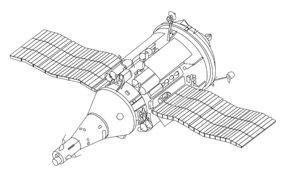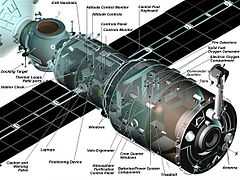Excalibur Almaz
| Private | |
| Industry | Aerospace |
| Founded | Isle of Man (2005) |
| Headquarters | Douglas, Isle of Man |
Key people | Arthur M. Dula, CEO |
| Website | excaliburalmaz.com |
Excalibur Almaz is a private spaceflight company which plans to provide a variety of deep space crewed exploration missions, micro-gravity science, and payload delivery. EA also aims to offer Low Earth Orbit cargo and crew delivery and return.[1]
Design and flight safety reviews are planned for 2015.[2] According to a 2012 interview with Art Dula, the chairman of Excalibur Almaz, the Excalibur Almaz capsule is supposedly on a "very high level of technical readiness" and could be flown within 2 to 3 years. The main issue of the first manned flight of the Excalibur Almaz capsule is regulatory, according to Dula, as the VA capsule had already done 9 unmanned test flights during the Almaz program, all of which were successful.[3] The company has competed under NASA's Commercial Crew Development program but was not selected to receive funding under any phases of it.
History
In 2009, Excalibur Almaz hoped to begin flights by 2012 with revenue flights starting as early as 2013.[5][6]

As of January 2012, Excalibur Almaz updated its mission service offerings to include lunar and deep space capabilities. Based on independent market studies, these missions beyond Low Earth Orbit will provide the best business opportunity for commercial space transportation companies. Because of these more ambitious service offerings, Excalibur Almaz has pushed back its first launch to 2015.[2]
In June 2012, Excalibur Almaz signed an agreement with XCOR Aerospace for suborbital familiarization and flight training services.[7]
Company
Excalibur Almaz is based in Douglas, Isle of Man, with offices in Houston and Moscow.
In October, 2011, NASA signed an unfunded Space Act Agreement for work related to the Commercial Crew Development program. Details have not yet been released.[8] In July 2012, Excalibur Almaz Inc. (EAI) successfully completed its Commercial Crew Development Round 2 (CCDev2) partnership with NASA's Commercial Crew Program.[9]
Jonathan Clark, NASA flight surgeon on six Space Shuttle missions—and whose wife, Laurel Clark, died in the Space Shuttle Columbia disaster on shuttle mission STS-107—is a consultant on spacesuit and crew biological environment design for Excalibur Almaz.[10]
Operations
Spacecraft
Excalibur Almaz is designing a spacecraft based on the VA capsule hull from the TKS spacecraft. The VA is a space capsule from the Soviet space program, originally designed for the military Almaz space station program. The needed development of propulsion systems for the VA capsule was reportedly delegated to an then undisclosed European organization as early as 2009.[11] While the needed service module for an Excalibur Almaz capsule would superficially resemble the FGB of the TKS spacecraft, it is based on Astrium's ATV design according to Art Dula, the chairman of Excalibur Almaz.[4]
The potential Excalibur Almaz stations will use two hulls from the Almaz space station program. An Almaz derived hull is still in use on the Zvezda ISS service module (DOS-8) in the Russian Orbital Segment of the International Space Station; Thus the Excalibur Almaz stations would be distantly related to the similarly sized Zvezda module of the ISS.
The company’s Soviet-era spacecraft were moved from Russia to Excalibur Almaz facilities on the Isle of Man in early 2011. EA "plans to use the modules to provide extra room and supplies for the tourists and researchers it hopes to ferry into space."[12] Excalibur Almaz’s two Salyut-class 29-ton space stations, each with a capacity of 95 cubic meters will serve as the heart of its lunar and deep space capabilities. The two spacecraft are equivalent to the Russian Mir core or the International Space Station Zvezda module. The Soviet-era electronics have been completely gutted and supposedly replaced with modern avionics supplied from an unnamed company.
By using modernized, tried-and-tested equipment rather than developing technology from scratch, the project is reportedly saving around $2 billion in development costs. The Russian Proton rocket, launched from the Baikonur Cosmodrome in Kazakhstan, is intended to be used to launch one of the spacecraft into space, where it will remain. Astronauts will use the Excalibur Almaz RRVs to get to and from the spacecraft.[2]
Training
Excalibur Almaz has established a 2012 agreement with XCOR Aerospace to provide a suite of suborbital flight experiences as training milestones in preparation for orbital and trans-lunar missions.[13]
Space launch services
In 2010, Excalibur Almaz partnered with Space Launch Services (SLS) to finance Sea Launch's preparations to emerge from Chapter 11 with $12 million (USD) of debtor-in-possession (DIP) financing to provide investment in a financial reorganization of Sea Launch. SLS earlier provided $12.5 million of DIP funds to Sea Launch in December 2009.[14]
Auction of Almaz Capsule
A secondhand Soviet-era space capsule that launched into space twice is set to be sold in Belgium on Wednesday (2014-05-07).
The Russian VA (Vozvraschaemyi Apparat, return vehicle) crew and cargo spacecraft is being offered by the Berlin-based Lempertz auction house at its newly opened gallery in Brussels. Estimated to sell for $1 to $2 million (US), the capsule is said to be the first historic spacecraft to be put up for sale in Europe.
The VA capsule was sold to Excalibur Almaz (EA), a British company that planned to reuse the Soviet artifacts to offer commercial spaceflight services. In total, EA acquired four VA capsules and two Almaz (Salyut) modules in hopes of flying the combined spacecraft as a crew and cargo transportation system to the moon, the asteroids and deep space.
The VA spacecraft being offered still bears the Excalibur Almaz name and logo, as well as the flags of Russia, the United Kingdom, the Isle of Man and the United States.[15]
Sources
- Siddiqi, Asif A., The Almaz Space Station Complex: A History. 1964-1992, part 1, JBIS, Vol 54, No 11/12, November/December 2001.
- Excalibur Almaz Limited AAS Presentation, 16 November 2005
- Dr. Jamie Floyd, Assessment of the Almaz Capsule for Space Station Assured Crew Return (ACRV), McDonnell Douglas Aerospace MDC 97W5151, January 1997.
References
- ↑ "XCOR and Excalibur Almaz sign MOU for suborbital training services" (Press release). XCOR Aerospace. 20 June 2012. Retrieved 6 July 2012.
- ↑ 2.0 2.1 2.2 Ben Rooney (20 June 2012). "Fly Me to the Moon". Wall Street Journal. Retrieved 6 July 2012.
- ↑ "Interview with Art Dula (Chairman Excalibur Almaz) - Part 4". moonandback.com (vimeo.com). Retrieved 4 September 2012.
- ↑ 4.0 4.1 "Interview with Art Dula (Chairman Excalibur Almaz) - Part 2". moonandback.com (vimeo.com). Retrieved 4 September 2012.
- ↑ Craig Covault (18 Aug 2009). "Beating swords into plough shares with Soviet Almaz". Spaceflight Now. Retrieved 6 July 2012.
- ↑ Keith Cowing (18 Aug 2009). "Excalibur Almaz to Pioneer Private Orbital Manned Space Flight In cooperation with NPOM of Russia". OnOrbit alpha. Retrieved 6 July 2012.
- ↑ Charles Black (21 June 2012). "XCOR to provide spaceflight experience for Excalibur Almaz missions". Wired UK. Retrieved 6 July 2012.
- ↑ "Excalibur Almaz gets an unfunded CCDev agreement". NewSpace Journal. 2011-10-26. Retrieved 2011-10-27.
- ↑ "NASA and Excalibur Almaz Inc. Complete Space Act Agreement" (Press release). NASA. 6 July 2012.
- ↑ Luke Dittrich (14 July 2010). "The Man Who Would Fall to Earth". Esquire. Retrieved 6 July 2012.
- ↑ "Almaz Excalibur". RussianSpaceWeb.com. Retrieved 30 August 2012.
- ↑ Rachel Courtland (12 Jan 2011). "Fledgling space firm will use old Soviet gear". New Scientist. Retrieved 6 July 2012.
- ↑ "XCOR & Excalibur Almaz sign agreement on suborbital training services" (Press release). XCOR Aerospace. 20 June 2012. Retrieved 6 July 2012.
- ↑ Sea Launch Gets Court Approval To Raise More Money
- ↑ Robert Z. Pearlman (6 May 2014). "Used Spacecraft for Sale: Soviet-Era Space Capsule Up for Auction in Belgium". collectSpace.com.
External links
- Grahn, Sven. ‘’The Almaz Space Station Complex’’
- Wade, Mark. ‘’Almaz’’
- Russian Space Web. ‘’The Almaz Program’’
| ||||||||||||||||||||||||||||||||||||||||||||||||||

